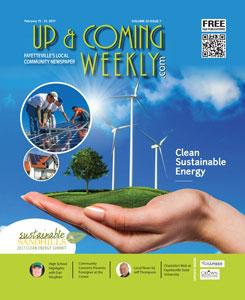 For such a small organization, Sustainable Sandhills has a big impact on the community. From green schools programs to forums about climate preparedness to an environmentally-focused film series and locavore pop up dinners, this organization is not afraid to get creative when it comes to important issues. On March 10-11, Sustainable Sandhills and Fayettevile Technical Community College will host the Sandhills Clean Energy Summit. Each day includes a keynote luncheon with a speaker along with several forums, discussions and panels covering topics related to just about every aspect of clean/renewable energy.
For such a small organization, Sustainable Sandhills has a big impact on the community. From green schools programs to forums about climate preparedness to an environmentally-focused film series and locavore pop up dinners, this organization is not afraid to get creative when it comes to important issues. On March 10-11, Sustainable Sandhills and Fayettevile Technical Community College will host the Sandhills Clean Energy Summit. Each day includes a keynote luncheon with a speaker along with several forums, discussions and panels covering topics related to just about every aspect of clean/renewable energy.
“Friday is more focused on the business perspective. We will have professionals in sustainable energy fields there to talk, as well as people who work in energy policy,” said Denise Bruce, green action coordinator at Sustainable Sandhills. “So if you are a small-business owner looking to find out about clean energy or learning about how energy policies affect business and industry, this is a day you won’t want to miss. Something that I think will be really fun is that we are touring a local solar farm at the end of the day. Tickets for the tour are limited, though. Those who don’t go on the tour are invited to stay and network.”
The event is at FTCC. Doors open at 11 a.m. The keynote luncheon runs from 11:30 a.m. to 12:45 p.m. Bruce noted that this is the only part of the event (each day) that requires purchasing a ticket. It is $25 per ticket to attend the luncheon.
From 1-2 p.m. Friday, attendees can choose from three topics: Renewable Energy Investing and Infrastructure opportunities for Your Business; Land Use Planning for Solar Installation; and Solar Farm Operations and Maintenance.
From 2:15-3:15 p.m., topics include The State of Energy in North Carolina and Energy Efficiency in Business and Government.
At 3:15 p.m., loading for the solar tour begins. Departure for the tour is at 3:30 p.m. At FTCC, from 3:30 p.m., attendees are invited to attend a networking session with representatives from Key Energy and Tom Butler of Butler Bio Farms.
Saturday is more consumer oriented. “We will be talking about things like jobs in the clean energy field and how people can get training that will prepare them to work in this field. We will also be talking about things like climate resilience and social justice and power.”
Saturday’s events also begin with registration, which runs from 11 – 11:30 a.m. Opening remarks are at 11:30 a.m.followed by a speaker.
Topics from 1-2 p.m. cover home energy efficiency, training and workforce development opportunities and climate resilience. From 2:15-3:15 p.m., speakers will talk about social justice and power, community solar issues and electric vehicles and EV infrastructure. Climate talks and closing remarks are from 3:30 p.m. to 4:30 p.m.
In conjunction with the Clean Energy Summit is the World Climate Simulation. It takes place March 11 from 9:30 a.m. to 5 p.m. at the FTCC General Classroom building. It is an interactive simulation of the International Climate Negotiations. A collaboration between Climate Interactive and MIT, this simulation is based on the COP22 climate conference held in Marrakesh, Morocco, in November 2016. Participants are cast in roles as world leaders who have gathered to produce an agreement to reduce CO2 emissions enough to limit global warming to 2 degrees Celsius by the year 2100. Register at gogreen.ccs.k12.nc.us.
Speakers throughout the Clean Energy Summit include professionals and experts in their respective fields.
Gary Bilbro is president of SMART Recycling U.S., which provides services including food waste diversion to composting, anaerobic digestion and energy generation. SMART is claimed to be the cleanest, easiest, least expensive and most efficient food diversion program that exists.
Jay Blauser is UNC Pembroke’s first sustainability director and chief sustainability officer. Blauser and his team work to minimize the university’s global warming emissions and to educate graduates about social, environmental and economic issues.
Mark Brown is Senior Customer Programs Officer at Fayetteville Public Works Commission. His team develops energy and water efficiency programs, services and tools that make it possible for PWC customers to take advantage of the company’s smart grid initiatives.
Stephan Caldwell is the creator of the Grease for Good program. This program helps communities see how locally-made biofuels can benefit the community not only as an energy source but also as a tool to educate and inspire others.
Kacey Hoover has a strong technical background in regulatory, government affairs, and market trends pertinent to the industry. Hoover currently serves as North Carolina Sustainable Energy Association’s Strategic Relations Manager.
Ken Jennings is the Renewable Strategy & Policy Director for Duke Energy Carolinas and works out of the Raleigh Office. He’s held numerous business roles and ultimately landed in the regulatory policy field. Throughout his career, he has developed new generating facilities, managed business analytics teams, testified in numerous rate proceedings in multiple states.
Jodie Lasseter will attend on behalf of Power Up NC. Lasseter works closely with community leaders and environmental justice organizations to build grassroots power throughout the U.S. and abroad.
Katie LeBrato is the marketing communications director at NC GreenPower. She brings leadership to their Communications Working Group and Sustainability Group.
Jay Lucas works for the Public Staff of the North Carolina Utilities Commission where he has managed the regulatory aspects of the state’s Renewable Energy and Energy Efficiency Portfolio Standard since 2009.
To find out more about Sustainable Sandhills or to register for the Clean Energy Summit, visit http://www.sustainablesandhills.org/sandhills-clean-energy-summit.